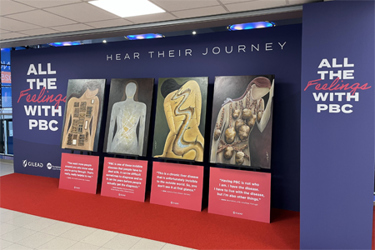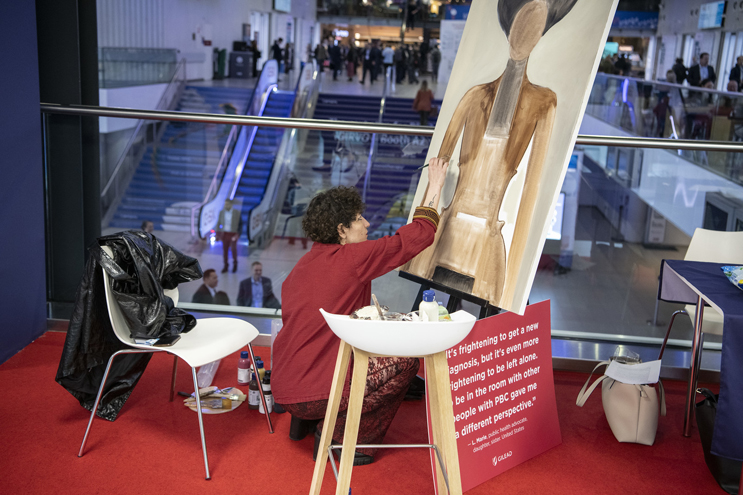Gilead Art Campaign Captures The PBC Patient Experience, Inspires Patient-Centric Trials
A conversation with Carrie Frenette, executive director, global medical affairs, liver, inflammation, respiratory and emerging viruses, and established products, Gilead Sciences, Inc.

Getting conference attendees to stop by your booth is challenging. With mere minutes to dart from one session to another, conference-goers have little time to linger at even the most interesting and informative displays.
But in bringing an easel to EASL (European Association for the Study of the Liver Congress), Gilead did to attendees what it hopes to do for a wider public: make them slow down and see what’s right in front of them. With its “All the Feelings with PBC” life art experience, Gilead welcomed viewers to witness the artist Nour Khwies paint the portrait of a person living with primary biliary cholangitis (PBC).
A sometimes debilitating disease affecting the liver, PBC can present symptoms that silently plague patients (itch and fatigue, primarily) and that others cannot see and therefore have difficulty understanding. With this art campaign, Gilead brought the patient experience to the forefront, educating passersby and informing their own work in developing treatments and trials for PBC.
Clinical Leader’s Abby Proch discussed the artful endeavor and its implications for clinical trial design with Gilead’s Carrie Frenette.
How did this idea for the art experience illustrating PBC come about?
We know that many people with PBC have symptoms that aren't necessarily visible, like extreme fatigue, chronic itching, joint pain, and body aches. The symptoms of PBC are not well discussed, and a lot of time they're misunderstood. Sometimes people are even dismissive of the symptoms, even though for the individuals, they can be debilitating. PBC is a rare disease, and there's not a lot of public awareness. The combination of having the invisible symptoms and the lack of public awareness can leave people feeling isolated and their experiences minimized.
At Gilead, we've been talking about the patient experience and how to really bring this to life in a way that's going to emotionally resonate with healthcare providers, with those outside the healthcare community, and with researchers.
We all know that artwork can be deeply moving, and so we were hoping that this artwork would be a powerful reminder. We launched it at EASL to encourage physicians to look beyond the labs and think about what the people in front of them are feeling.
How did you learn about this artist, and why did you choose her to live paint at the Congress?
The team did a really thorough and thoughtful vetting process to find an artist capable of translating the lived experiences of people with PBC into a body of artwork that’s both emotionally resonating and visually compelling.
We reviewed portfolios of several talented artists. But Nour's work really drew us. Technically, she's an amazing artist, but she has this ability to infuse every piece with emotion and have the viewers of her art captivated by their feelings.
But before we finalized it, we shared the short list of candidates with the PBC Foundation, one of the largest patient advocacy groups for PBC, for feedback, and they were immediately enthusiastic and felt an instant connection. It made her the clear choice.

How did she draw her inspiration, or what direction did you provide to get her started?
We arranged for her to meet with four women living with PBC so she could directly hear each person's unique story — her path to diagnosis, the symptoms she has, how she feels about them, how the symptoms affect her daily life, and how her life was before and after the diagnosis of PBC. A key part of this was understanding not just their medical experiences but their personalities and their emotions and the resilience they have to have when living with this disease.
She then created four paintings to capture the essence of each woman's story (one of which was captured live at EASL). She also added a fifth piece, which was a depiction of this invisible person living with PBC, symbolizing that many of these people struggle in silence. They don't know how to interpret their symptoms or they don't know how to bring them up with their healthcare provider, often causing a delay in diagnosis.
The paintings are absolutely beautiful, and they really draw people in and invite them to reflect deeply and encourage healthcare providers to connect emotionally with the story behind the art.
Where will this artwork continue to have an audience?
If you've ever been to a major meeting, the people who are attending are running from one place to another. It's busy, it's fast-paced. And it was so amazing to see people stop and look at these paintings. We actually had people comment that they immediately recognized that the paintings were about PBC even without explaining it. And then we had healthcare providers say it is going to make them reconsider how they think about PBC the next time they see a patient. I even saw people getting very emotional as they viewed the paintings. A lot of people stopped by, watched Nour paint, and stood there much longer than you would expect for a busy meeting like EASL.
We're going to continue to work on getting these paintings out there. We're actually working with a filmmaker in Los Angeles, Jay Weneta, who is working on a film to explore these stories and showcase the artistic process. And that's going to be premiered during PBC Awareness month in September. And then we're going to continue to socialize these paintings. They’ll be on display at Gilead’s Foster City campus in California, which is the company’s headquarters.
How does this art campaign help Gilead better understand the patient experience, and how it would translate that understanding into the drug development cycle?
We have been focusing on getting and understanding patient insights to use in our clinical trial work to create studies that are much more patient-centric. We get feedback from patients’ experiences, their preferences, and their barriers to participating in a study, and then we use those to help shape trial design, like inclusion, visit schedules, and what endpoints matter most to patients. We can have the best clinical trial in the world, but if it doesn't matter to patients, it's not going to make as much of an impact. So, we’re focusing on using this art to better understand trial accessibility and patient experience to reach more meaningful outcomes and greater alignment with patient needs.
With this experience, you're not only collecting and capturing very objective patient experiences, but you're also tying in emotions to have some staying power with your researchers.
A hundred percent. It's one thing sitting in an office talking about itch or fatigue, but now you have this emotional connection to this art that reminds you of what people are actually going through. I think that is going to have the staying power, much more so than just talking about which measuring tool to use when we're thinking about itch. There are great tools that are many questions long, but patients will say, “I don't want to do that all the time because it's 50 questions.” So, we’re trying to simplify that and say, “Well, does this one resonate with you? Is this something that is going to translate your experiences correctly into a way that can be included in a clinical trial?” And honestly, I don't know that medicine in general is at the point where in every disease process and in every symptom, we have the perfect way to measure the actual experience of the patient. But the only way we're going to get there is to talk to patients and learn. That's where we need to continue to push.
About The Expert:
 Catherine Frenette, MD, FAST, AGAF, FAASLD, is the executive director in global medical affairs for liver disease, inflammation, respiratory and emerging viruses, and established products at Gilead Sciences. She trained in transplant hepatology and gastroenterology and has held leadership roles in liver transplant and cancer programs at Scripps. In her clinical practice she treated many patients with primary biliary cholangitis and other liver diseases. In 2022, she joined Gilead to further the science of liver disease. She has published over 75 articles on various topics in the field of liver disease.
Catherine Frenette, MD, FAST, AGAF, FAASLD, is the executive director in global medical affairs for liver disease, inflammation, respiratory and emerging viruses, and established products at Gilead Sciences. She trained in transplant hepatology and gastroenterology and has held leadership roles in liver transplant and cancer programs at Scripps. In her clinical practice she treated many patients with primary biliary cholangitis and other liver diseases. In 2022, she joined Gilead to further the science of liver disease. She has published over 75 articles on various topics in the field of liver disease.
